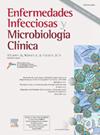通过在急诊科实施机会性筛查来检测以前未确诊或未随访的丙型肝炎感染
IF 2.5
4区 医学
Q3 INFECTIOUS DISEASES
Enfermedades infecciosas y microbiologia clinica
Pub Date : 2025-10-01
DOI:10.1016/j.eimc.2025.03.008
引用次数: 0
摘要
目的本研究旨在评估机会性丙型肝炎病毒(HCV)筛查项目在识别新病例和确保其随访(与护理联系)方面的有效性。方法:我们于2023年6月至2024年5月在加泰罗尼亚(西班牙)的急诊科(ED)进行了一项前瞻性研究,筛选了30-70岁的患者,这些患者作为常规临床实践的一部分采集了血液样本。抗HCV抗体阳性的患者通过HCV RNA检测确诊,活动性感染的患者转介到消化内科治疗。结果在15245例符合条件的患者中,5184例接受了HCV筛查,与前一年相比增加了192%。在所有血清学中,年龄在30-70岁之间的患者要求3973例,其余为常规临床实践。120例(3.02%)患者检测到抗HCV抗体,13例(0.33%)患者存在活动性HCV感染。病毒血症患者平均年龄49.62岁,男性占76.92%。确定的危险因素包括吸毒(63.64%)和来自HCV高流行国家(18.18%)。25%的患者出现晚期肝纤维化。结论:与普通人群相比,ED的机会性筛查显著增加了HCV检测,并确定了更高的活动性感染患病率。这些发现支持扩大筛查指南以覆盖更广泛的人群,改善HCV的早期诊断和与护理的联系。本文章由计算机程序翻译,如有差异,请以英文原文为准。
Detection of previously undiagnosed or lost to follow-up hepatitis C infections by implementing an opportunistic screening in an emergency department
Objectives
This study aimed to evaluate the effectiveness of an opportunistic hepatitis C virus (HCV) screening program in identifying new cases and ensuring their follow-up (linkage to care) in our health area.
Methods
We conducted a prospective study from June 2023 to May 2024 in an emergency department (ED) of Catalonia (Spain), screening patients aged 30–70 years who had blood samples collected as part of routine clinical practice. Patients with positive anti-HCV antibodies were confirmed with HCV RNA testing, and those with active infection were referred to the gastroenterology department for care.
Results
Out of 15,245 eligible patients, 5184 were screened for HCV, marking a 192% increase compared to the previous year. Of total serologies, 3973 were requested in patients aged between 30–70 years and the rest by routine clinical practice. Anti-HCV antibodies were detected in 120 patients (3.02%), and 13 (0.33%) had active HCV infection. The mean age of viremic patients was 49.62 years and 76.92% were male. Identified risk factors included drug use (63.64%) and being from countries with high HCV prevalence (18.18%). Advanced liver fibrosis was found in 25% of patients.
Conclusions
Opportunistic screening in the ED significantly increased HCV testing and identified a higher prevalence of active infection compared to the general population. These findings support expanding screening guidelines to reach broader populations, improving early diagnosis and linkage to care for HCV.
求助全文
通过发布文献求助,成功后即可免费获取论文全文。
去求助
来源期刊
CiteScore
2.10
自引率
8.00%
发文量
194
审稿时长
29 days
期刊介绍:
Hoy está universalmente reconocida la renovada y creciente importancia de la patología infecciosa: aparición de nuevos agentes patógenos, de cepas resistentes, de procesos con expresión clínica hasta ahora desconocida, de cuadros de una gran complejidad. Paralelamente, la Microbiología y la Infectología Clínicas han experimentado un gran desarrollo como respuesta al reto planteado por la actual patología infecciosa. Enfermedades Infecciosas y Microbiología Clínica es la Publicación Oficial de la Sociedad Española SEIMC. Cumple con la garantía científica de esta Sociedad, la doble función de difundir trabajos de investigación, tanto clínicos como microbiológicos, referidos a la patología infecciosa, y contribuye a la formación continuada de los interesados en aquella patología mediante artículos orientados a ese fin y elaborados por autores de la mayor calificación invitados por la revista.

 求助内容:
求助内容: 应助结果提醒方式:
应助结果提醒方式:


